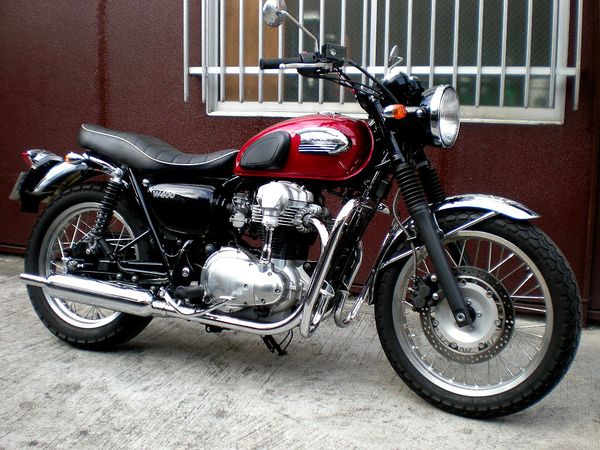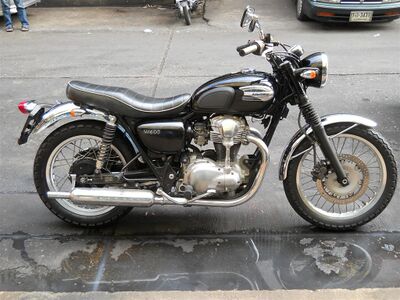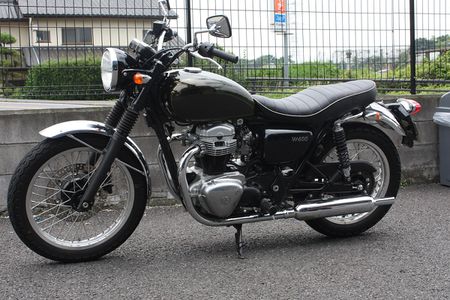Difference between revisions of "Kawasaki W400"
m |
m |
||
| Line 5: | Line 5: | ||
}} | }} | ||
__notoc__ | __notoc__ | ||
| − | [[file: Dscn0042.jpg | | + | [[file: Dscn0042.jpg | 600px | center | Kawasaki W400]] |
The model of the retro-classic motorcycle "Kawasaki W400" "was released in 2006 as a" little brother "[[Kawasaki_W650 | Kawasaki W650]] and was intended primarily for the domestic market in Japan. Both models differ from each other in engine displacement, suspension settings and overall dimensions - the W400 model is generally lower and slightly smaller in size. | The model of the retro-classic motorcycle "Kawasaki W400" "was released in 2006 as a" little brother "[[Kawasaki_W650 | Kawasaki W650]] and was intended primarily for the domestic market in Japan. Both models differ from each other in engine displacement, suspension settings and overall dimensions - the W400 model is generally lower and slightly smaller in size. | ||
{{Ads_top}} | {{Ads_top}} | ||
Latest revision as of 16:40, 13 July 2023
The model of the retro-classic motorcycle "Kawasaki W400" "was released in 2006 as a" little brother " Kawasaki W650 and was intended primarily for the domestic market in Japan. Both models differ from each other in engine displacement, suspension settings and overall dimensions - the W400 model is generally lower and slightly smaller in size.
Lineup:
Main competitors:
In general, the emergence and development of the modern W-series of Kawasaki motorcycles was due to the company's desire to compete with Triumph Bonneville and occupy the niche of modern retro classics. This was only done in the Japanese and European markets, while in the US the Kawasaki W650 had extremely low sales.
The main feature of the Kawasaki W400 is an air-cooled, 2-cylinder in-line engine that produces 29 hp. power and 29 Nm of torque. The maximum engine performance is reached at 6000-7500 rpm.
Other features of the Kawasaki W400 include a steel tubular frame, kick starter with electric starter, rear drum brakes and classic suspension in the form of a conventional telescopic fork and double shock absorber (adjustable for preload). In general, the Kawasaki W400 model is very simple in technical terms, which makes it quite reliable.
The Kawasaki W400 and Kawasaki W650 models were produced until 2008, after which they were discontinued due to the new emission standards. They were replaced by the Kawasaki W800, which had a larger engine and was equipped with electronic fuel injection, but generally retained the features of the previous W-series models.
Photos
Specifications
Specifications Kawasaki W400:
| Model | Kawasaki W400 |
|---|---|
| Motorcycle type | retro classic |
| Release year | 2006-2008 |
| Frame | steel tubular |
| Engine type | 2-cylinder, 4-stroke, in-line |
| Working volume | 399 cc cm. |
| Bore / Stroke | 72.0 x 49.0mm |
| Compression ratio | 8.5: 1 |
| Cooling | air |
| Number of valves per cylinder | SOHC, 4 valves |
| Fuel supply system | Carburetor, 2x Keihin CVK30 |
| Ignition type | transistor |
| Maximum power | 29.0 h.p. (21 kW) at 7500 rpm |
| Maximum torque | 29.0 Nm (3.0 kgf * m) @ 6000 rpm |
| Gearbox | 5-speed |
| Drive type | chain |
| Front tire size | 100 / 90-19 M / C 57H |
| Rear tire size | 130 / 80-18 M / C 66H |
| Front brakes | 1 disc, 300 mm, 2-piston caliper |
| Rear brakes | drum |
| Front suspension | 39mm telescopic fork, 130mm travel |
| Rear suspension | linkage with other shock absorbers (adjustable preload), stroke - 105 mm |
| Motorcycle length | 2175 mm |
| Motorcycle width | 855 mm |
| Motorcycle height | 1115 mm |
| Wheelbase | 1460 mm |
| Saddle height | 765 mm |
| Acceleration to 100 km / h | |
| Maximum speed | 140 km / h |
| Fuel tank capacity | 15.0 l |
| Motorcycle weight | 193 kg - dry
209 kg - equipped |
Documentation



